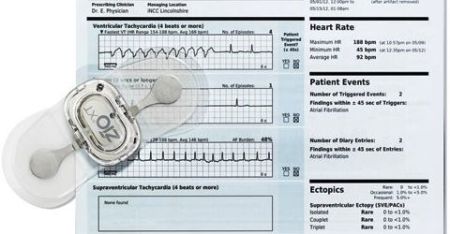iRhythm Technologies, a healthcare information services company, announced that a prospective study by Scripps Translational Science Institute (STSI) has found that in comparison to the traditional Holter monitor, use of the company’s ZIO Service significantly increased detection of cardiac arrhythmias.
The findings, published and made publicly accessible online in the January issue of the American Journal of Medicine, underscore the role of the ZIO Service, comprised of the ZIO Patch, proprietary algorithms and ZIO Report, as the new standard for ambulatory monitoring of patients with suspected arrhythmia.
“This is the first large prospective validation that this new technology superseded the device invented by Norman Holter in 1949,” said study senior author Eric Topol, M.D., a cardiologist who directs STSI and serves as the chief academic officer of Scripps Health.
“By tracking every heart beat for up to two weeks, the ZIO Service proved to be significantly more sensitive than the standard Holter, which uses multiple wires and typically is only used or tolerated for 24 hours. For millions of people who present each year with suspected arrhythmia, this may prove to be the new standard for capturing the culprit heart rhythm electrical disturbance, most commonly atrial fibrillation which carries a significant risk of stroke,” he said.
The prospective study included 146 consecutive Scripps Health patients who were referred for evaluation of cardiac arrhythmias and underwent simultaneous ambulatory ECG monitoring with a ZIO Patch, a patch worn on the chest, which continuously records heartbeats for up to 14 days, and a conventional 24-hour Holter monitor, a portable machine with multiple wires that connect to electrodes on the chest.
Over the total wear time of both devices, the ZIO Service detected 57% more arrhythmia events compared to the Holter monitor (96 versus 61), primarily due to prolonged monitoring.
Physicians also reported that they arrived at a definitive diagnosis in 90% of cases using the ZIO Service, compared to 64% with the Holter monitor. Furthermore, 81% of patients reported they preferred the ZIO Patch versus the Holter monitor.
Each year, millions of patients present with infrequent and non-specific symptoms such as heart palpitations, dizziness and shortness of breath, which may or may not be caused by cardiac arrhythmias.
Reports estimate that the three most common types of arrhythmia – atrial fibrillation (AF), bradycardia and ventricular tachycardia – affect approximately 8 million people in the United States each year. If not treated properly, arrhythmias can lead to serious complications such as stroke.
Effective management of cardiac arrhythmia is specific to the type of arrhythmia identified. Arrhythmias, however, are often difficult to diagnose using current monitoring techniques, which are limited in what they can record or can be difficult for patients to use or tolerate.
Source: iRhythm Technologies
4 January 2014
Latest Articles
Stroke, Arrhythmia, Cardiovascular, Cardiac, cardiac arrest, ischemic stroke, heart disease
iRhythm Technologies, a healthcare information services company, announced that a prospective study by Scripps Translational Science Institute (STSI) has f...



























